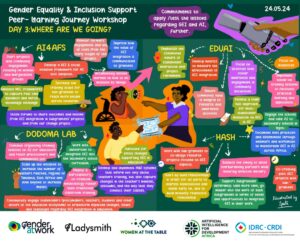 by Mahelet Hailemariam (G@W Associate)
by Mahelet Hailemariam (G@W Associate)
I am an associate member of Gender at Work based in Ethiopia. I am one of the team facilitating the School Related Gender Based Violence (SRGBV) action learning process initiated by Education International and UNGEI in Ethiopia, Uganda and Kenya. My role was to facilitate the gender action learning processes and to mentor the change teams in their initiatives to address SRGBV. The mentoring process included following up progress and providing technical support to the change teams as needed.
During one mentoring session, I was sitting in a small, dark and congested conference room with the change team, administration and program members. All of them knew each other very well. I was the only outsider. There were three men among the participants. I saw one of the men sitting at the edge of the chair. He looked as if he was getting ready to quickly leave the room. A second man was reading from a magazine in front of him, while the third stood in a corner of the room pretending to read from a poster on the wall. I guessed that they were feeling out of place and wondered why. The female participants, oblivious of their surroundings, were chatting and laughing.
After a brief welcome and introduction, we started by revising what had happened in the previous action learning sessions. A female participant, from the administration department, asked a question. “I wanted to learn more about what SRGBV is? I want to understand how I can identify SRGBV?” Based on her question and recognizing that not everyone in the room had participated in previous trainings, we started our discussion.
In the middle of the conversation, one of the men pushed the table forward, struggled to stand up and spoke. He said “oh gender!” something sounded familiar to me, in his tone and the way he stood. I had seen this before. He was not completely convinced about SRGBV or gender equality. He continued talking about how this issue marginalizes men by focusing only on women. His female colleague tried to explain. He stretched himself out on his chair and looked away, as she spoke. I could see he was not convinced. Was he even listening? He seemed not interested to hear her response.
As the discussion went on I struggled with myself internally. Should I change the workshop program I had worked on for days back home? When developing the program, I had assumed that there would be no need to define what SRGBV is or what gender equality means. As I reflected now, I thought “am I jumping to a conclusion prematurely?”. “Am I not being judgmental?” However, I felt I needed give participants the chance for discussion on what was at hand before proceeding. I could see defining some concepts such as gender and SRGBV was important, so instead of sticking to what I thought should happen, I allowed the process to be led by the participant’s needs and in my mind I started adjusting the program.
I was anxious, but what choice did I have except thinking on my feet? After all, how can we (as facilitators) remain relevant in such a process where what we prepared beforehand did not fit what was actually going on in the room?
As I reflected in my mind, on how to adjust the programme, another participant added to the discussion by saying “S.R.G.B.V.” emphasizing each letter very slowly, as if this was the first time he was saying this. He concluded “it happens everywhere, people do not understand it, we teach them what it is…what it means…”
We heard story after story of SRGBV. Painful stories. This girl was raped in this school and the teacher got away with it. This female teacher was harassed by so and so and finally she was transferred. Stories of teachers caning students, students abusing and harassing teachers. The stories went on and on. “I heard that this girl was dressed in a mini-skirt.” “This teacher was walking outside alone in the dark”. These were explanations given in some of the stories we were hearing. I thought “are these attempts to justify the act?” Or “was it an attempt to understand human behaviour, to understand how anybody can be able to commit such a crime?” “Are we not blaming the victims?” I felt myself choking. I felt suffocated and all of a sudden I seized the opportunity and almost shouted “acts of violence should be condemned for what they are!”
Most of the stories seemed to focus on what men have done to this girl and that. My mind wondered “what is it that I am hearing, what are we saying/implying? Are we saying that only men are perpetrators and have no control over their feelings? Are women the only victims?” Too many questions came to my mind, and the discussion continued before I was able to articulate any of my thoughts into questions that would help participants explore the issue from different angles.
My mind continued racing, while at the same time listening to the discussion following my last comment. A participant who seemed overwhelmed by the discussion offered “we need to work on awareness raising. Parents, teachers, students, government should be aware of what is happening.” Her comment triggered another thought in me and I said to myself “how easy it is to externalize and talk about what is happening out there and what we can do out there”. While I was mumbling inside, one of the participants almost rescued me. She said “Change starts from within us”. How I loved that participant for saying what she said, how relieved I felt because I thought that was the exact moment to bring up the issue of looking inside oneself and inside the organization itself. And without thinking much, I asked “can we please share instances or examples of GBV in the office?”
No one saw this coming, and all of a sudden, the room descended into heavy silence. I did not expect that reaction so feeling a bit of guilt, I tried to explain what I meant as if they did not get what I had asked the first time.
Again, nothing. I looked around hoping someone would rescue me. Nothing. Just 20 eyes staring back at me. Some looks conveyed that they could not believe what they had just heard. What have I done? Feeling scared that I had blocked discussion, I asked myself what if I was wrong? What if staff in the organization have never experienced GBV? What if they were staring back at me because it was not my place to ask such a question? What if these looks were saying “Who do you think you are?”
I wanted to jump to another topic but could not. I thought I saw a smile on one lady’s face which seem to say “Yes, that was what I was looking for”. I could not believe what I saw and turned away. I definitely saw a small nod from a participant at the far end of the table, he seemed to be scanning the room, trying to make sure others did not see him. This encouraged me to pursue the topic. But how?
I knew I needed to take a risk. I could not leave the issue, but at the same time I realized I had made an incorrect assumption. All of a sudden, I sort of felt angry at myself for being insensitive and ignorant. I said to myself, “am I crazy, what makes me think that this is something they will talk about without fearing consequences?” “How can anybody feel safe to talk openly about such things in such a setting? I am an outsider. I will leave at the end of this workshop, but …” My own internal struggle forced me to put myself in their shoes.
I do not know how many minutes went by.
Some eyes were no longer fixed on me. Some female participants were exchanging faint smiles across the room, while another one seem to be busy scribbling on her notebook…
The room remained silent!
From the intensity of the silence, and the body languages of some of the participants I decided to pursue the issue but to change my approach. My dilemma was how to continue the discussion, create space where people could learn from their own experience in a way that was safe and not judgmental.
Out of desperation, I came up with an idea. I tried to compose myself and asked “Please write a letter to a dear friend, giving an example of instances where GBV took place in the office. And please, submit your letter without identifying your name.”
I promised I would be as careful as possible in handling the information and the letters.
Without hesitation participants started writing and quickly submitted their letters. After reviewing the letters overnight, the following day I shared the very long lists of examples they had identified. To my surprise no one objected, and people started talking openly about how to use the information to initiate change in their organizational cultures.
Reflecting back on this experience makes me realise how much we have to hold as facilitators. I guess I was lucky that day. I believe I need to thank the participants for trusting me and the process. This does not mean I will get lucky every time. So the questions are for us as facilitators, “how can we work in ways that expand participant’s experiences? How can we facilitate in such a way that people acquire not only skills but also the willingness to look at themselves critically and to change? How can we do that without asking difficult questions? Without taking risks?”
To know more about the initiative: https://genderatwork.org/education-unions-take-action-to-end-srgbv/.
The views, opinions and words written in the article are solely those of the author. The article reflects the author’s journey, view point and progress in their own words.



